› Forums › Variable Stars › Nova in Cas
- This topic has 39 replies, 12 voices, and was last updated 3 years, 12 months ago by
 Jeremy Shears.
Jeremy Shears.
-
AuthorPosts
-
25 August 2020 at 4:17 pm #583042
 Kevin GurneyParticipant
Kevin GurneyParticipantSnap!
I took this at about the same time (been away for a few days so only processing now…)
Reassuring to see close similarity.
I have some accompanying photometry so aim for flux calibration soon…
Kevin
25 August 2020 at 4:24 pm #583043 Kevin GurneyParticipant
Kevin GurneyParticipant…removing duplicate – apologies..
Kevin
25 August 2020 at 9:19 pm #583044 Mike HarlowSpectator
Mike HarlowSpectatorInteresting passing comment in the latest ATel 13967 on the nova:
Quote: “…dust formation will almost certainly take place sometime in the next several weeks.”
So I guess a dramatic fade can be expected??? Well worth watching at every opportunity.
Mike.
26 August 2020 at 11:26 am #583046 Gary PoynerParticipant
Gary PoynerParticipantThe Nova is now fading from it’s second maximum, very slightly fainter than the first. Most unusual. Reminds me of V5558 Sgr (Nova Sgr 2007).
Gary
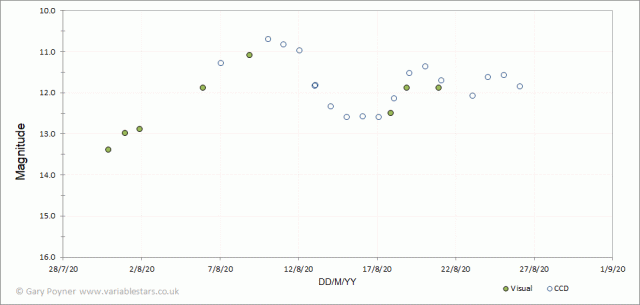 2 September 2020 at 4:55 pm #583072
2 September 2020 at 4:55 pm #583072 John CoffinParticipant
John CoffinParticipant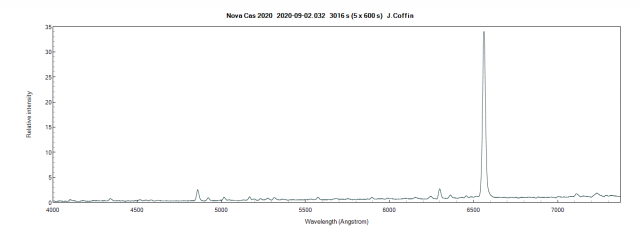
H alpha is still prominent, possibly even brighter. It needs someone cleverer than me to do a flux calibrated spectrum. I’ve attached a plot of three spectra taken over the last three weeks to show the changes. This object continues to fascinate me. Any interpretation of what we are seeing would be welcome.
 2 September 2020 at 5:28 pm #583073
2 September 2020 at 5:28 pm #583073 Paul G. AbelParticipant
Paul G. AbelParticipantIf ever we get a clear sky in Leicester, I’ll take a look. My 12” Newtonian should pick it up.
6 September 2020 at 9:41 pm #583090 Jeremy ShearsParticipant
Jeremy ShearsParticipantThis nova has received the official VS designation, V1391 Cas.
7 September 2020 at 11:19 pm #583092 David BoydParticipant
David BoydParticipantJohn,
I calibrated your 3 spectra in the BAA database in absolute flux using V magnitudes interpolated at the times of your spectra from V magnitudes in the AAVSO photometric database. I have labelled the main emission lines which include the Balmer series of hydrogen recombination lines and collisionally excited lines of singly ionised iron Fe II. The latter have strengthened during the recent rebrightenings of the nova. There are also forbidden lines of oxygen [O I] formed in the lower density expanding nebula.
David
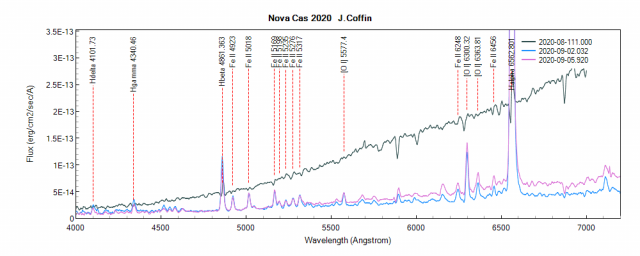 10 September 2020 at 9:34 am #583095
10 September 2020 at 9:34 am #583095 John CoffinParticipant
John CoffinParticipantThanks very much for that. Maybe next year you will be able to teach us how to do this, perhaps in another spectroscopy workshop.
14 September 2020 at 9:17 am #583102 John CoffinParticipant
John CoffinParticipantLast nights spectrum shows P Cygni profiles in He I, Fe II, Na I and [O I] which have deepened or appeared since 5th September.
1920p
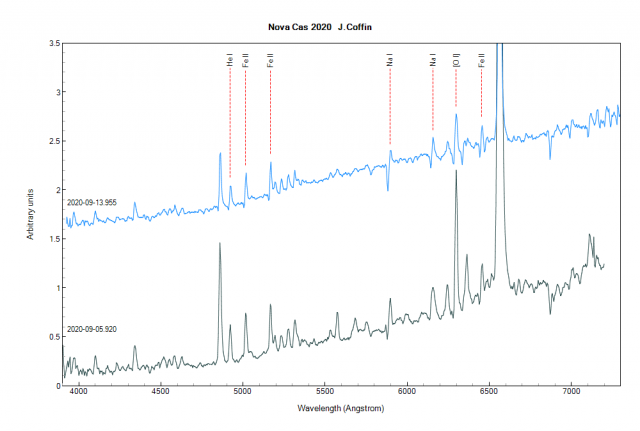 24 September 2020 at 8:50 pm #583164
24 September 2020 at 8:50 pm #583164 Stewart John BeanParticipant
Stewart John BeanParticipantI have the following for V1391 Cas from 23 Sept 2020:
V filter 12.95,
B filter 14.4 ,
I filter 10.19
Values are in the database. Stewart
26 September 2020 at 7:07 pm #583179 John CoffinParticipant
John CoffinParticipant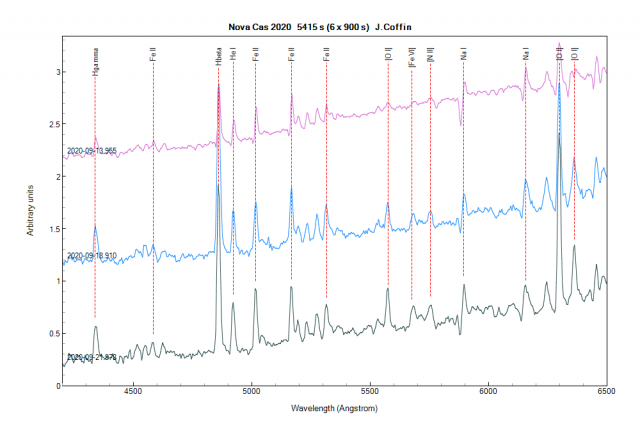
It looks as if there are P Cygni profiles in sodium. Is the sodium interstellar, and if so, what causes the P Cygni profile? Is the emission component due to photoexcitation by UV from the white dwarf or some other mechanism? Thanks.
22 December 2020 at 10:14 pm #583605 Mike HarlowSpectator
Mike HarlowSpectatorRecent Astronomers telegrams report that dust formation is happening in this nova explaining the recent deep fade. See ATel14272 and ATel14267 for details. Also recent images illustrating the fade are on my members page.
23 December 2020 at 11:40 am #583607 Gary PoynerParticipant
Gary PoynerParticipantThis classic DQHer dust dip started slowly in late November and increased in mid December. Here is my plot so far…
Gary
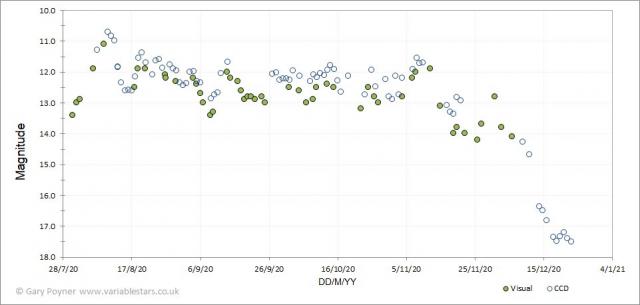 28 December 2020 at 11:56 am #583617
28 December 2020 at 11:56 am #583617 Mike HarlowSpectator
Mike HarlowSpectatorImaged the nova last night and it is barely detectable now. Presumably if it does behave like DQ Her it should brighten again in the next month or so? Well worth keeping an eye on…!
Mike
28 December 2020 at 2:51 pm #583619 Gary PoynerParticipant
Gary PoynerParticipantI’ve seen a number of ‘dust dips’ over the years, and 6 weeks in low state seems to be a fair average time before a rise sets in again in the very obvious ones. There are exceptions – for example, V2362 Cyg (Nova 2006) faded 4 mags from 8-12 before a 16 week plateau set in, then rebrightened to mag 10 before a very rapid decline followed by a gradual fade to quiescence. This was a dusty Nova, but the hot dust was probably confined to the inner region of the system. Going on the quite unusual behaviour so far seen in V1391 Cas, it will be interesting to see what happens next over the coming months.
Gary
5 February 2021 at 8:54 pm #583794 Nick JamesParticipant
Nick JamesParticipantThe nova is just visible on an image taken tonight at around mag 20. I’ve not seen it on stacks with a similar limiting magnitude to tonight’s image so it may be on the rise again.
6 February 2021 at 10:23 am #583795 Nick JamesParticipant
Nick JamesParticipantThe AAVSO lightcurve shows recent observations between 18-19 which I am sure are wrong. I’ve been keeping this star under regular observation and I have not seen it this bright since early January. The nova is only a few arcsec south of a 17th mag star and I think that is affecting measurements. In the thumbnail below, taken from my image of last night, the nova is visible faintly between that star and a fainter one further to the south. The fainter star is 18.5 and the third star at the right angle of the triangle is fainter than 19. The nova is much fainter than that. I get 20.1 in a 4 arcsec radius aperture which is offset 2 arcsec south to avoid including the 17th mag star.
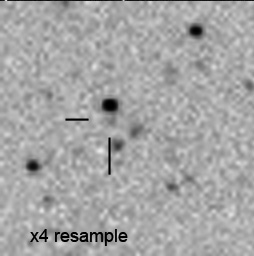 9 March 2021 at 7:27 pm #583929
9 March 2021 at 7:27 pm #583929 Nick JamesParticipant
Nick JamesParticipantThe nova has been steadily brightening for a few weeks and tonight I get it at 17.42. At this rate it will be brighter than the close star just to the north in a few days. An interesting object to follow just as Cassiopeia is getting low in the north. How bright will it get?
8 January 2022 at 1:29 pm #585096 Jeremy ShearsParticipant
Jeremy ShearsParticipantUpdated light curve until end 2021. This nova is still at mag 17 and worth following
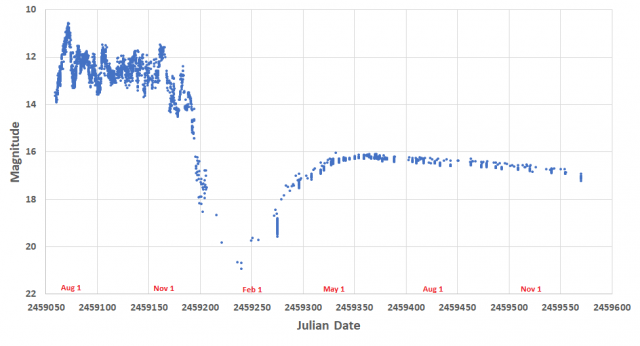
-
AuthorPosts
- You must be logged in to reply to this topic.
